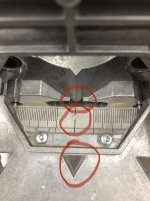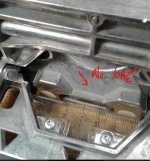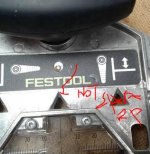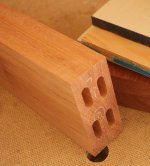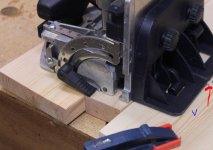I will do my best to explain what is going on. There are 3 alignment points on top of the machine and one on the bottom. The 3 on the top are: 1. the point on the machine 2. the black line on the moveable clear plastic, 3. The triangle. On the bottom of the machine there is the engraved line.
Over the last few months I noticed that the domino would not align. I would make the cuts, insert the domino and it would be mis aligned by a good 2mm. To overcome this I would just cut one of the slots on the lose setting so I could get it aligned. But with a tool this price, you shouldn't have to do this. I decided to send it into Festool for repair. This tool originally was purchased back in 06 when they first came available in the States. I get a call a few days later saying the bearings were worn and they needed to be replaced and they did some adjustments to the vertical fence. I call to try and talk to the technician to make sure they fully understood the problem and they assured me the problem was fixed.
I get it back about a week later and immediately notice that the vertical portion of the fence was all jacked up and I hadn't even said anything about repairing that. I then make a couple lines to check and see if the horizontal alignment issue was resolved and it was not. I was able to get a good alignment using the triangle. But the black line on the plastic was off and the point on the machine were way off. I can adjust the plastic piece and get that aligned, but I cant adjust the point on the machine.
Since I was having problems with the vertical fence, I decided to get the Seneca domiplate. That uses the line on the bottom of the unit. But that was also off by about 2mm and is not adjustable.
My question is, is this fixable? I have already sent it to Festool to fix the problem and it came back the same. Is there something I can do? I hope that I explained this well enough. If you need more information, please let me know.
Over the last few months I noticed that the domino would not align. I would make the cuts, insert the domino and it would be mis aligned by a good 2mm. To overcome this I would just cut one of the slots on the lose setting so I could get it aligned. But with a tool this price, you shouldn't have to do this. I decided to send it into Festool for repair. This tool originally was purchased back in 06 when they first came available in the States. I get a call a few days later saying the bearings were worn and they needed to be replaced and they did some adjustments to the vertical fence. I call to try and talk to the technician to make sure they fully understood the problem and they assured me the problem was fixed.
I get it back about a week later and immediately notice that the vertical portion of the fence was all jacked up and I hadn't even said anything about repairing that. I then make a couple lines to check and see if the horizontal alignment issue was resolved and it was not. I was able to get a good alignment using the triangle. But the black line on the plastic was off and the point on the machine were way off. I can adjust the plastic piece and get that aligned, but I cant adjust the point on the machine.
Since I was having problems with the vertical fence, I decided to get the Seneca domiplate. That uses the line on the bottom of the unit. But that was also off by about 2mm and is not adjustable.
My question is, is this fixable? I have already sent it to Festool to fix the problem and it came back the same. Is there something I can do? I hope that I explained this well enough. If you need more information, please let me know.

